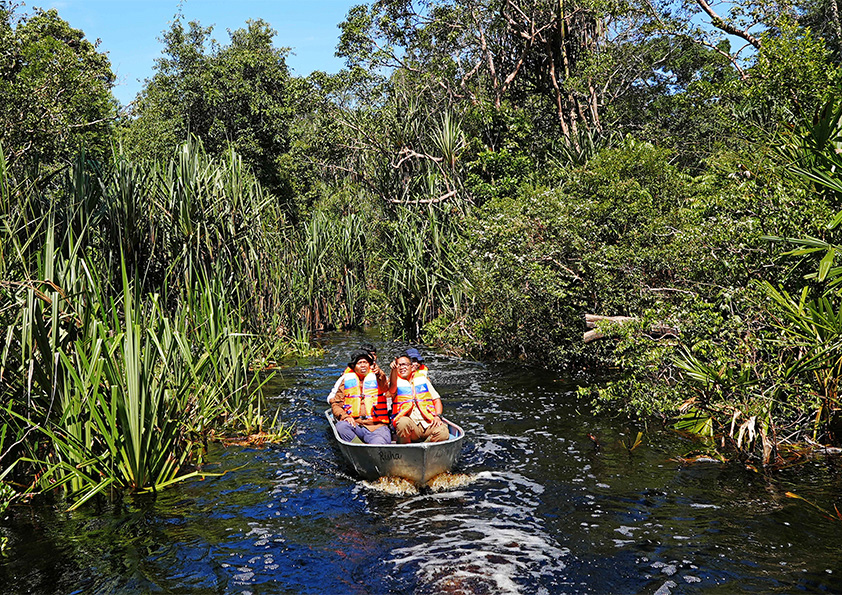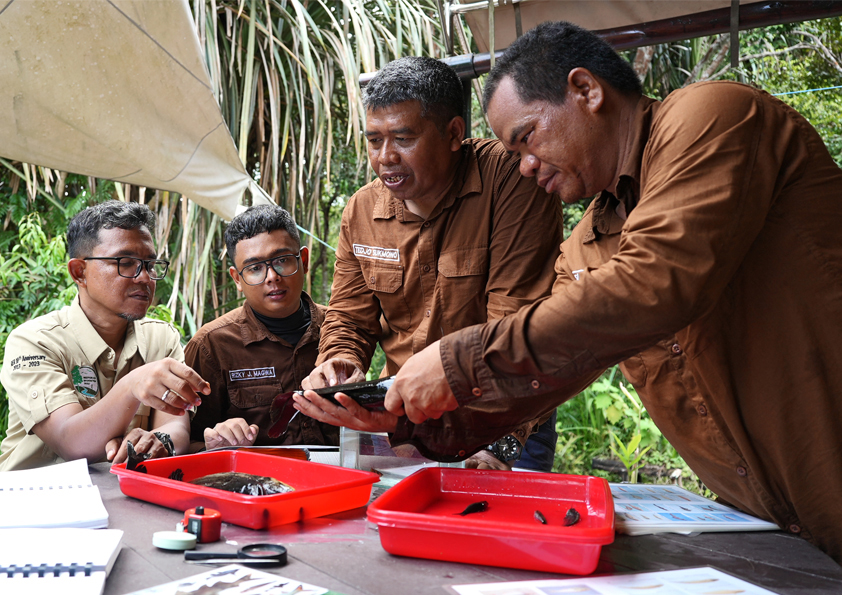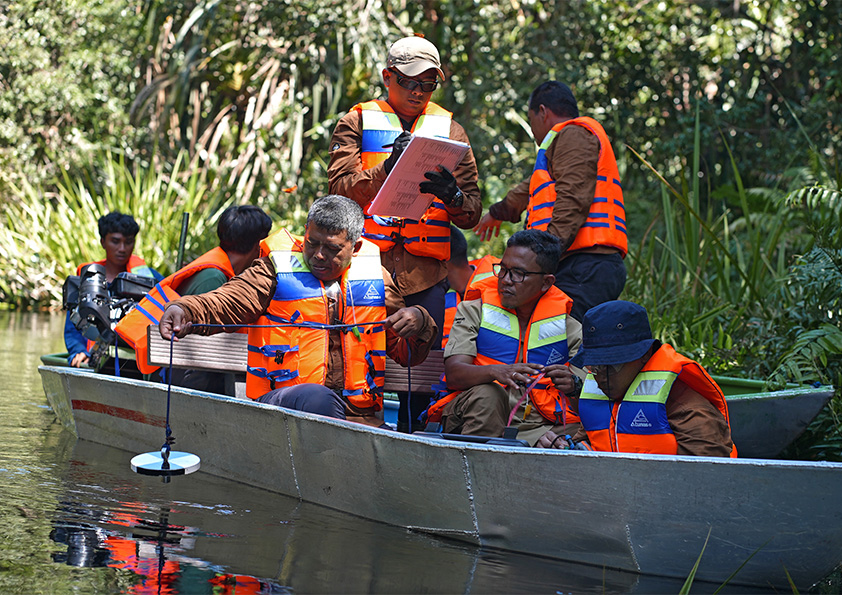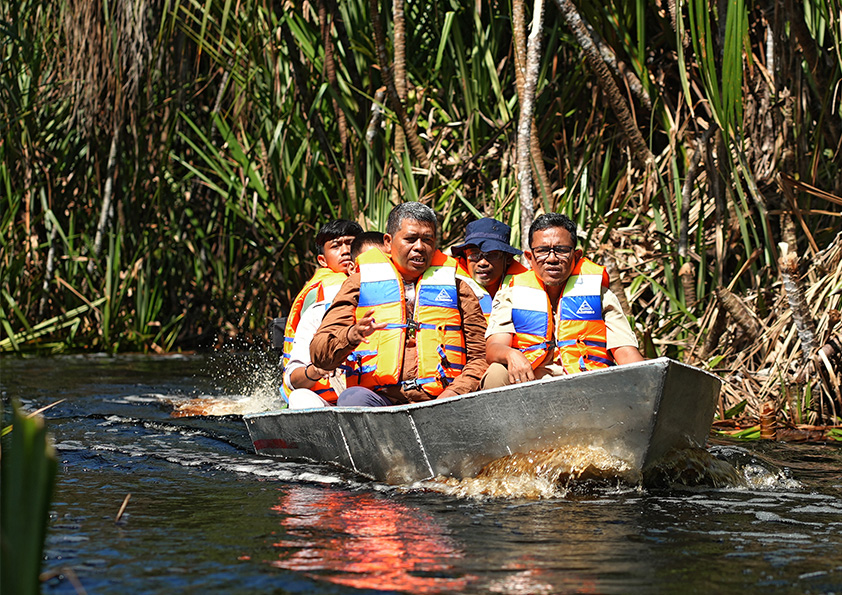August 25, 2025
Restorasi Ekosistem Riau (RER) is committed to using science-based solutions to conserve and protect more than 150,000 hectares of Sumatra’s peatland forest and its biodiversity. By partnering with local and international scientists, RER advances peatland research that informs restoration and supports long-term monitoring.
Over the years, RER has supported studies ranging from odonata (dragonflies and damselflies) to the Malayan sun bear. Its most recent initiative is a freshwater fish survey led by Dr Tedjo Sukmono, freshwater fish taxonomist and lecturer from Jambi University. Spanning rivers, lakes, and canals across the Kampar Peninsula, the study aims to provide a more comprehensive picture of fish diversity in RER.
“RER is a natural laboratory,” says Yoan Dinata (Nata), RER’s Research and Monitoring Manager. “The diverse habitat types and facilities, such as the Peat Lab and remote guard posts, allow students, researchers, and conservationists to work together to understand peat ecosystems.”
In this article, we will explore why the fish survey is necessary, why it is conducted in RER, the methods used, and what the findings mean for RER’s work and broader biodiversity conservation.

How Fish Reflect Peatland Health
RER’s landscape includes about 400 kilometres of peat rivers, 14 isolated peat lakes, and a network of canals. During the wet season, the rivers overflow and form small lakes, then separate again in the dry season. This natural cycle distributes freshwater fish across the landscape, making the area “a hotspot for fish biodiversity”, says Dr Tedjo.
Freshwater fish represent more than just species richness; they are sensitive to environmental changes, particularly in fragile habitats like peat swamps, making them bioindicators that reflect the health of rivers, lakes, and surrounding peat forests. “A wide variety of fish signals intact ecosystems and successful restoration, while declines can warn of stress or degradation,” Dr Tedjo explains.
Despite their importance, studies of freshwater fish in peat swamp forests remain rare. In unexplored areas, Dr Tedjo notes, researchers often find new records or even potentially new species.
In 2017, he led RER’s first fish survey, mainly in the rivers, and recorded 89 species across 49 genera and 19 families. Among them were local endemics and paedocypris progenetica, the world’s smallest fish at less than one centimeter long. Building on that baseline, the 2025 survey aims to expand the record by sampling not only rivers but also lakes and canals.

How Researchers Document Fish Biodiversity in RER
The fish survey in RER began in January 2025 and will run for 12 to 18 months, following a careful and systematic approach:
1. Selecting survey habitats
The research team chooses rivers, lakes, and canals, dividing them into zones. Each zone has survey stations where sampling is repeated twice to ensure reliable results.
2. Measuring water quality
Before fishing begins, the fish survey team records clarity, temperature, pH, oxygen levels, and surrounding vegetation.
3. Locating and capturing fish
Using fish-finders, the team identifies likely spots and deploys nets. Traps are left for about three hours before being checked, both during the day and at night.
4. Identifying specimens
Familiar species are listed immediately, while uncertain ones are checked against fish catalogues. Each fish is photographed, weighed, and given an ID code.
5. Collecting DNA samples
For potentially new or ambiguous species, small tissue samples are taken to confirm whether they are indeed new to science.
This fieldwork in RER will be followed by three months of data analysis and another three months of reporting. Even at this stage, the survey shows promising results. “We expect the numbers to increase from the 89 species recorded in 2017, possibly to 120 or even 150,” Dr Tedjo says.

How RER Turns Data into Impact
The findings from the fish survey in RER will be compiled into a field guide and shared through scientific publications. The results will also be used to compare natural lakes and rivers with human-made canals. “This will provide valuable insights for ecosystem management, helping RER identify priority areas for protection, monitoring, and restoration,” says Nata.
Sustaining fish populations also supports local communities and their livelihoods. That is why RER works closely with fishermen to promote sustainable practices, replacing harmful methods such as poisoning or electrocution with safer techniques that protect both biodiversity and income. “Together with fishermen, RER builds a shared commitment to protect fish populations and ensure long-term benefits for the community,” Nata adds.
Moving forward, RER will continue collaborating with researchers to deepen understanding of peatlands through its ongoing biodiversity surveys, expanding to include other species and ecological interactions. These efforts strengthen RER’s role as a hub for science-based conservation in Sumatra, Indonesia.
Frequently Asked Questions (FAQ)
1. Why does RER collaborate with scientists?
RER partners with local and international scientists to ensure its conservation work is based on solid evidence. Research provides the data needed to guide restoration, monitor progress, and improve long-term management of Sumatra’s peatlands.
2. Why is it important to research fish biodiversity in peatlands?
Freshwater fish are bioindicators, meaning their presence reflects the health of rivers, lakes, and forests. Studying fish in peatlands helps measure ecosystem recovery and can also reveal new or rare species that highlight the uniqueness of these habitats.
3. What makes RER’s landscape ideal for a fish survey?
RER’s area includes 400 kilometres of peat rivers, 14 peat lakes, and canals. Seasonal flooding and drying create diverse habitats, making it a hotspot for freshwater fish biodiversity.
4. How does RER support the fish survey?
RER provides facilities such as the Eco Research Camp, the Peat Lab, and guard posts that allow scientists to work safely in remote areas. These resources make it possible to conduct systematic surveys across rivers, lakes, canals, and forests.
5. How does RER use data from research like the fish survey?
Findings are compiled into field guides and scientific publications, helping RER identify priority areas for protection and restoration. The results also guide ecosystem management and support sustainable practices with local fishing communities.
